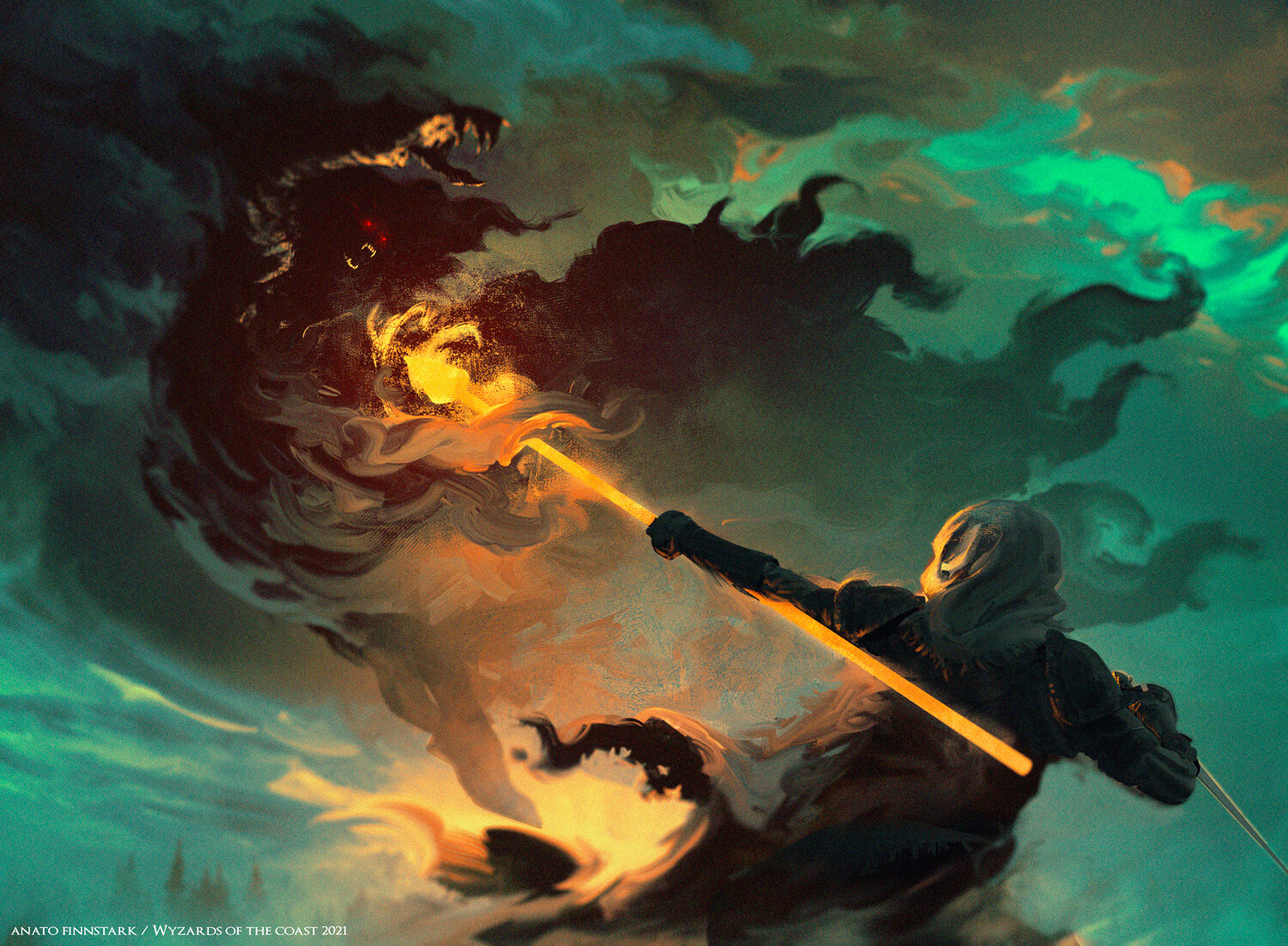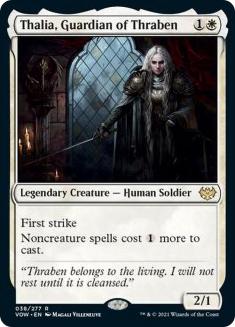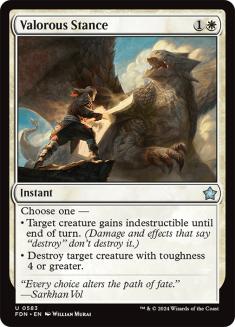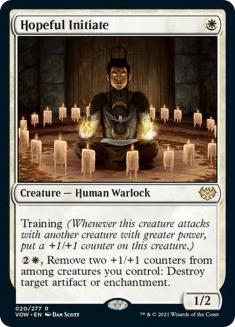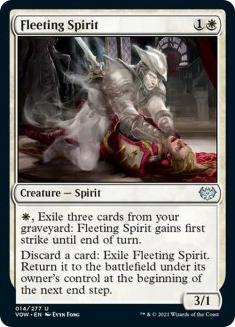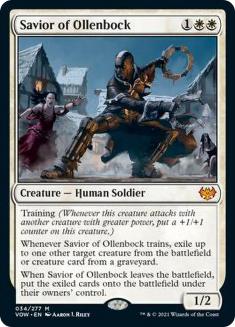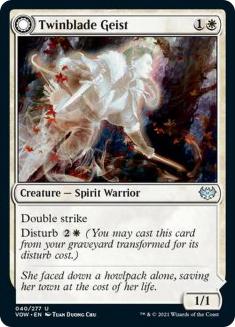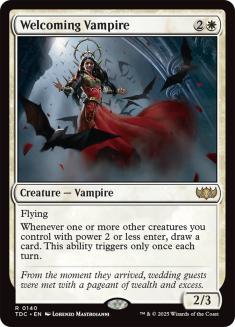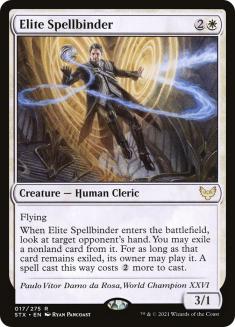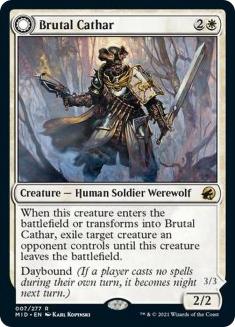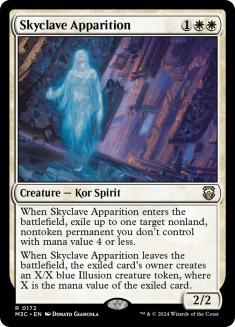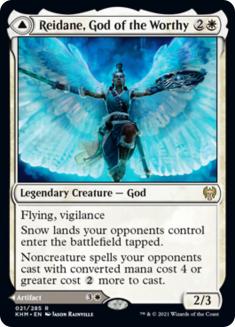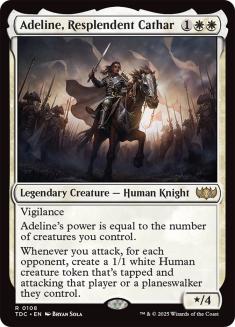By the time of Magic World Championship XXVII, I thought there were two clear best decks — Izzet Epiphany and Mono-Green Aggro❄ — with Mono-White Aggro❄ as a close third and nothing else in the same ballpark. Since then, Mono-White Aggro❄ has been putting up better and better results, to a point where I think we can say there are now three decks in Tier 1. These decks all have relatively even matchups among themselves and are overall favored versus the amalgamation of the rest of the field.
For reference, here’s the deck Rei Sato and his teammates played at Magic World Championship XXVII:
Creatures (29)
- 4 Luminarch Aspirant
- 4 Usher of the Fallen
- 3 Reidane, God of the Worthy
- 4 Elite Spellbinder
- 3 Stonebinder's Familiar
- 4 Intrepid Adversary
- 4 Sungold Sentinel
- 3 Adeline, Resplendent Cathar
Lands (24)
Spells (7)

With the release of Innistrad: Crimson Vow, all three Tier 1 decks have gained new tools, but I think Mono-White Aggro❄ gained the most by far. When a deck that was already one of the best decks in the format gains powerful new tools, we have to pay attention.
Here are the possible inclusions:
Thalia, Guardian of Thraben is a very powerful card with a pedigree in basically every competitive Magic format, including Legacy. It can be incredibly disruptive to an opponent that relies on casting noncreature spells, and that’s going to be most people outside of the mirror match. It’s only a 2/1, so it’s vulnerable to basically everything, but the key is that, even when they do get rid of it, it’s already done part of its job, because invariably whatever card they are using to kill it is already going to cost one more, and that might be a whole turn sometimes.
Right now, this is a prime time for Thalia, because arguably the best deck in the format relies on casting a lot of spells, many of them in the same turn. A Galvanic Iteration + Alrund’s Epiphany combo costs eight mana, which is a lot but feasible, but with Thalia on the battlefield, that’s going to cost ten, which is much harder to achieve. Once we add in other tax effects such as Elite Spellbinder and Reidane, God of the Worthy, it might just become impossible.
Thalia isn’t only stopping their combo, though; it’s stopping their whole setup and defenses. A common play with the Izzet deck if you’re on the draw is to pass Turn 1 and then deal with whatever two-drop they cast, either via Spikefield Hazard or via Fading Hope. If your two-drop is Thalia, this plan simply doesn’t work and they have to spend Turn 2 dealing with it.
Other common sequences also get hurt badly by Thalia. For example, the standard play pattern with Expressive Iteration is to wait until Turn 3 to cast it, so that you can play a land as a free card. If you pass Turn 2 without making a play with the intention of doing this Turn 3 and they slam Thalia, it’s a devastating scenario — you now basically missed out on a whole turn for no gain. Similarly, one of the strongest sequences against beatdown decks is Turn 2 foretell a Demon Bolt, Turn 3 Galvanic Iteration + Demon Bolt to kill two creatures for three mana; if one of these creatures is a Thalia, this play costs five mana, at which point it might be way too late. That’s not even mentioning Jwari Disruption, which is already awkward on the draw but nigh-unplayable opposing a Turn 2 Thalia.
Izzet Epiphany is not the only deck hurt by Thalia, though. Most other decks in the format rely on big spells (for example Blood on the Snow, or even stuff like Deadly Dispute), and even the other aggro deck in the format, Mono-Green Aggro❄, can feel its effects, as delaying an Esika’s Chariot by a turn can often be the difference between winning and losing the game.
It also might look like Blizzard Brawl is not very affected by it, given that it only costs one mana to begin with, but in that matchup the Mono-Green deck usually falls behind, and they need Blizzard Brawl to cost one so that they can double-spell to catch up. For example, they might cast a Blizzard Brawl and a two-drop on Turn 3, or a Blizzard Brawl and a four-drop on Turn 4. If Blizzard Brawl costs two mana, they simply can’t do that, and casting Blizzard Brawl wastes their entire turn.
So, basically, Thalia is great. The only deck it’s not going to be good against is the mirror, but they will have Thalias as well, so it’s a wash. The deck was lacking in two-drops anyway, and it’s also a relatively good card to pump because it has first strike. The only question for me is whether I want to play three or four copies.
Mono-White wants to play some removal spells, but then it risks having dead cards against control matchups. This is a major problem against Izzet decks after sideboard specifically, where you need removal to not lose to Smoldering Egg but you also know removal will sit in your hand not doing anything half the games. The end result is that you have two-ish ways of removing it, which feels like both too many ways and not enough ways, depending on the game.
Valorous Stance is the perfect solution to this issue. It can kill Smoldering Egg and most other problematic creatures in the format (Goldspan Dragon; Lier, Disciple of the Drowned; Adeline, Resplendent Cathar; Esika’s Chariot; Wrenn and Seven tokens; even Skullport Merchant). If they don’t have any of those, you can use it to save one of your creatures from a removal spell or a sweeper.
Having Valorous Stance in your hand can allow you to go all-in on one creature with Luminarch Aspirant, for example, and then if they tap out to sweep the battlefield, you protect that one creature and win the game.
There are two main downsides of this card. The first is that it can’t deal with utility creatures, such as Brutal Cathar, Skyclave Apparition, and Luminarch Aspirant; those will usually not grow big enough for you to kill. The second is that it’s not as good as Fateful Absence against Blizzard Brawl specifically. One of the main uses of Fateful Absence in the Mono-Green Aggro❄ matchup is responding to a fight spell, but your opponent will often be able to fight with a smaller creature so as to avoid getting blown out by Valorous Stance.
The end result of this is that I believe Fateful Absence is better versus Mono-Green and versus Mono-White, but Valorous Stance is better against the rest of the field. The key here is that, when Fateful Absence is better, it’s a little better, but when Valorous Stance is better, it’s a lot better, which makes me think Valorous Stance is simply the superior option. Even if you prefer to play some Fateful Absences over Valorous Stances in the maindeck, they seem to be so important for the sideboard plan versus Izzet that I would like to go up to four copies after sideboarding.
Hopeful Initiate might not be the most powerful card in the world, but it’s a one-drop, and the bar for those is really low right now — people are so desperate for good one-drops that Battlefield Raptor has seen play. As far as one-drops go, I think it’s actually quite decent, as it has two relevant abilities.
Training might be a bit hard to evaluate without playing with it, but I think this is normally going to attack as a 1/2 on Turn 2, a 2/3 on Turn 3 and a 3/4 on Turn 4, given that getting a three-power attacker by Turn 4 is not that hard. This is a pretty good deal! It might be hard to grow it into a 4/5, but if you have Luminarch Aspirant on the battlefield it basically doubles the counters every turn. I think by itself this ability might be enough to justify the Hopeful Initiate inclusion, as it seems much easier to turn on than Stonebinder’s Familiar and also has an extra point of toughness.
The second ability is not going to come up a lot, but when it does come up, it will be very good. It’s not going to be hard for Hopeful Initiate to have two counters itself, but you can mix and match with, for example, Luminarch Aspirant targets (or even Stonebinder’s Familiar if there’s room for both). The prime target in Standard is Esika’s Chariot, but you’re also going to potentially hit Maul of the Skyclaves, Portable Hole, The Celestus, or Treasure tokens. Often you won’t need to use the ability because the threat of it will stop them from casting their artifact or enchantment anyway, so you might gain a benefit from it existing without ever having to spend mana and +1/+1 counters.
Fleeting Spirit is not as good as Seasoned Hallowblade, given that it can’t both deal damage and save itself if you don’t have the resources to give it first strike, but Seasoned Hallowblade was a very good card, and there’s room for a card to be worse and still good. The main issue might be that, by exiling it and bringing it back, you actually reset it, which means it’s not a good target for either Luminarch Aspirant or Maul of the Skyclaves. Hallowblade + Maul was a powerful opening, but Fleeting Spirit + Maul isn’t much better than any other two-drop + Maul.
On the plus side, it dodges certain things that Seasoned Hallowblade did not, such as exile effects and very importantly The Meathook Massacre. If you’re playing Stonebinder’s Familiar, it can also be used to trigger it.
The first strike ability is unlikely to come up early in the game, as this deck is mostly creatures, but if you do have three cards in the graveyard, then you might never have to actually use it. Similarly to Hopeful Initiate, the threat of the ability might be enough. For example, if you attack with Fleeting Spirit and they have a Kazandu Mammoth, they’re usually just not going to block, which means you don’t need to spend the mana and the cards, so next turn you can attack again.
Overall, I think this card is just okay, but playable if you need two-drops or if you’re specifically worried about sweepers. Right this moment, sweepers aren’t the most prevalent, and they cost enough mana that Thalia, Elite Spellbinder, and Reidane do a good job of protecting you, but if people start playing, for example, Doomskar, then it might become better.
Savior of Ollenbock is a weird card. Its main use is to have a recurring Banisher Priest effect, but it can also exile your own stuff in the graveyard as a hedge, so if they want to get their stuff back, you will get some of yours back as well. The main issue with this card (and several of the white cards) is that there’s a plethora of powerful three-drops in white right now, and it has to compete with some very heavy hitters.
If we compare Savior of Ollenbock to Brutal Cathar and Skyclave Apparition, then I think Savior has the biggest potential of them all. It can really run away with the game by itself, but it also has the lowest floor by a lot. If you play this and can’t attack with it, then it doesn’t do anything, and if they kill it right after you play, it also doesn’t do anything.
Overall, my inclination is that this is not good enough when it’s good to justify how bad it is when it’s bad. Brutal Cathar also has the ability to run away with the game if unopposed and is a stronger card if disrupted.
I don’t think Twinblade Geist is quite there yet, but it has a lot of potential. If you cast Twinblade Geist into Luminarch Aspirant it already attacks for four, the same as the other two-drops, and then it only compounds from there, especially with Maul of the Skyclaves. Then, if it dies, it gets to give something else double strike — ideally a powered-up flyer. I think we might need some more pump effects for this to be good, though, as right now it’s only really going to combo with about six cards in your deck, and it’s lackluster outside of that.
In a different universe, Welcoming Vampire might actually be good in a Mono-White Aggro deck, but I think right now we have so many good three-drops that it’s going to be relegated to sideboard duty at best.
So, these are the potential additions to the deck. Past that, I think the most important thing is figuring out which three-drops you want to play, because there are way too many great ones:
Adeline is the best “generic” three-drop; it’s going to be good against everybody. Past that, the cards are mostly specialized. They’re either good against creatures or good against spells, and you have to choose which one you want to beat. Of the remaining options, Elite Spellbinder will be best against the field in general, as it’s an anti-spells card with applications against aggro decks as well.
At Magic World Championship XXVII, Rei Sato opted to play Reidanes and Mauls, moving all of the Banisher Priest effects to the sideboard. I think this decision made sense given the metagame they expected, but right now things are a bit more creature-centric, so I’d like to play at least one of the exile creatures, as even the Izzet decks will often have targets (and besides, you already have Thalia to make a good Reidane impression).
Which of the exile creatures to play depends on what you expect other people to be doing. If people are interacting with your creatures, Skyclave Apparition is better because they don’t get their stuff back. If they’re not interacting with your creatures very much, Brutal Cathar is much better, both because it transforms into a more powerful attacker and also because you get to do it again. It really dominates the game against an aggro opponent who can’t remove it. Brutal Cathar is also much better against tokens, such as Wrenn and Seven.
Overall, I think Brutal Cathar is a bit better of a maindeck card, but I wouldn’t be opposed to playing a mix, and I’d certainly want Skyclave Apparitions in the sideboard.
When all is said and done, here’s what my Mono-White deck would look like right now:
Creatures (31)
- 3 Thalia, Guardian of Thraben
- 4 Luminarch Aspirant
- 4 Usher of the Fallen
- 4 Elite Spellbinder
- 2 Brutal Cathar
- 4 Intrepid Adversary
- 3 Sungold Sentinel
- 3 Adeline, Resplendent Cathar
- 4 Hopeful Initiate
Lands (24)
Spells (5)

For this build, I chose to eschew the Stonebinder’s Familiars altogether. Sungold Sentinel is not that great of a card (especially without the Familiar), but I think it’s still likely to be better than Fleeting Spirit. I will test Fleeting Spirit in its place for the moment to make sure, and it might surprise me, but if I had a tournament to play, this would be the list.
All in all, I believe this is the deck that got the most upgrades from Innistrad: Crimson Vow (outside of something like Vampires if that ends up existing). Given it was already a Tier 1 deck, I have no doubt it’s going to remain a major player for a while still.

